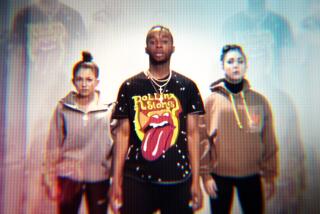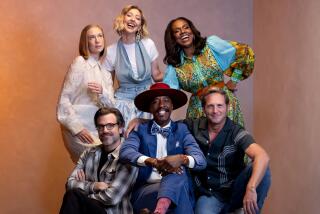A ‘Dance’ judge in La La Land
A seat on the “Hot Tamale Train” is no longer the benchmark of success on “So You Think You Can Dance.” There now is a more coveted ranking, a sweeter place known as the “Tra La La,” and, yes, only judge Mary Murphy can explain what that means.
She coined it this month, inspired by a Broadway routine performed flawlessly by hip-hop dancer Joshua Allen and his contemporary partner Katee Shean during Fox’s multidiscipline dance competition for aspiring performers. After the performance, Murphy screamed in her usual jubilant, uninhibited, practically deranged manner. “The two of you ought to come with a warranty -- satisfaction guaranteed! Wooooo!” before exalting that Allen was “going right in here into the Tra La La phase of my heart.”
Come again? The dancer sensed it was a compliment, as did the studio audience. But that’s as far as anyone was able to get with the accolade until a post-show visit to Murphy’s dressing room filled in the blanks.
“We have different layers of our heart,” Murphy explained, still visibly moved by the number. “There’s the initial acquaintance when you meet someone and you feel good being around this person. Then there’s the next level for closer friends. The ‘Tra La La’ is usually a place where you only let family, friends and pets that you’ve loved and lost. You don’t let just anyone in your life into that. It’s just the way it is. And Joshua is into mine.”
With that, Murphy released her famously raucous laugh. Then she continued. “There’s something about his essence and spirit that just radiates from him. It’s shining in his eyes. The joy of just being here.”
So, to be clear, when dancers enter the Tra La La zone, they have achieved something greater than landing a spot on the Hot Tamale Train, the gold standard Murphy established last season when a fiery jive performance prompted her to issue first-class tickets on the “hot tamale train” for the couple, confusing everyone around her, including executive producer and judge Nigel Lythgoe.
“If I put somebody on the train, it means they were really hot that night and could be heading into the finale,” Murphy said. “I should have put Joshua on the train, but I just couldn’t get it out. It just got to me. When I start getting emotional over something, it’s hard for me to put them on the train because they’re taking me to a different place. It’s not all fun. It’s Tra La La. It’s going into my heart and it’s affecting my cells.”
Laugh lineage
The LAUGH strikes again, and this time the former U.S. ballroom champion is in fits. Out of control. She knows she has a certain effect on people, having inherited her remarkable guffaw from her mother, whom Murphy promises has “a laugh twice as loud as mine: first it’s a scream and then a laugh.”
If that is the case, perhaps Mom is responsible for Murphy’s proclivities at the judge’s table. There is that laugh and the motivation behind her “Queen of Scream” moniker is obvious.
“But it’s so many other things,” Lythgoe said, noting why viewers both love and hate Murphy. “I still want to know what the Hot Tamale Train is. ‘Cutie Patootie.’ She just comes out with all these phrases, which I, a Brit, can’t understand. But I look around the room and Americans are also wondering what she’s talking about. She makes her own language up. You can tell if it’s good or bad by the way she’s doing it.”
The No. 2 show of the summer (behind “Hell’s Kitchen”) seems to be working just as well around the world. Murphy has served as a guest judge in Australia, Norway and Canada, where new formats of the show are highly popular and contestants live and die by Murphy’s reactions.
“The first time that I screamed, it just came flying out,” she said, over a lunch of edamame and mini-cheeseburgers at the Four Seasons Hotel. “I screamed bloody murder. I know I have a loud mouth and a loud laugh. But it really caught me off guard because all over the country -- and now the rest of the world -- people always ask, ‘Are you going to scream for me, Mary?’ Well, maybe. I don’t know! If I see something exciting I may scream. People ask me, ‘Can you laugh for me Mary, can you laugh for me?’ Well, yeah, if you say something funny. I am not a puppet, but I find it funny that it’s caught on all over the world.”
One thing that might surprise you is that the Queen of Scream is capable of being soft-spoken. OK, maybe that’s a bit of an exaggeration, but Murphy can speak in decibels that don’t send dogs packing or Lythgoe to a hearing specialist. Mostly, it happens when her tender side bubbles to the surface, like when she talks about the progress she is making in San Diego with her “Chance to Dance” program for underprivileged children, or after freestyle dancer Twitch and his contemporary jazz partner Kherington Payne light up the stage with a romantic Viennese waltz. This unexpected performance didn’t send Murphy squealing. Nor did it compel her to mention trains or Tra La La phases of the heart.
“It’s only the second week and Twitch makes me cry already,” Murphy said after the show. “And so does Joshua. For some reason, these two kids have struck an emotional chord inside my own heart.”
Her attachment to the dancers is fitting, given that working with promising performers has been the focus of Murphy’s career since she won the U.S. Open American Nine Dance, the national ballroom dance championship, in 1996 and then retired.
Murphy came into dancing somewhat accidentally after a high school and college career as a track star. An invitation at 19 to attend the U.S. ballroom championship in Manhattan changed the direction of her life from being a physical education teacher and track coach to becoming a superstar dancer in Europe and later the United States.
“It was almost like I was hit with a lightning bolt,” she said. “I was captivated. I saw how these people moved and the athleticism involved in it. I saw the competition aspects of it, which interested me because I had the sports background. And I told myself, ‘That’s it: I want to be a ballroom dancer.’ ”
But she never gave up on the idea of mentoring other performers. She opened her dance studio in San Diego in 1990 and later invested in three national dance companies when she retired to help others keep their ballroom dancing dreams alive.
She was beginning to wonder what her next move was when “So You Think You Can Dance” launched three years ago and producers hired her as a ballroom choreographer to work with contestants. When Murphy did her rotation on the judge’s table, as choreographers do on the show, something sparked inside Lythgoe. As the “American Idol” show runner, Lythgoe knows too well the value and necessity of reality-show judges in attracting water-cooler and blogosphere buzz. Murphy is to Lythgoe what Paula Abdul is to Simon Cowell, he said with a laugh, noting that Murphy is “very adept at defending herself and standing out.”
“She’s a great character, which is very important for me,” he said. “Whether people like her or hate her, she polarizes an audience, if you like, but she leaves the audience with an impression, which is the most important thing that you need to do as a television character. A very loud impression. Now, people come on the show and if they don’t get a Mary Murphy scream, they’re disappointed.”
This baffles and amuses Murphy.
“The dancers want a scream! People on the street want to be screamed at! Who would have known?” Murphy said. “It’s crazy to me! All those years of dancing and it’s the screaming. Now, if I had been screaming on the corner of Sunset, what would have happened? I would have been put away!”
The laugh rolls out again, but no scream follows it. The loudest reality TV show judge is saving herself for Wednesday and Thursday nights.
--
maria.elena.fernandez @latimes.com
More to Read
The biggest entertainment stories
Get our big stories about Hollywood, film, television, music, arts, culture and more right in your inbox as soon as they publish.
You may occasionally receive promotional content from the Los Angeles Times.










